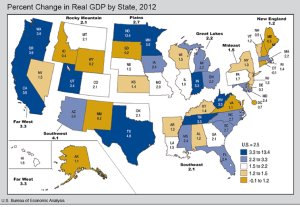Southwest U.S. Outpaces Rest
Friday, June 14th, 2013
In a report from Wall Street Journal’s Real Time Economics, we learned that the West region registered the highest level of economic growth in 2012. Increased demand from commodities from developing nations helped natural resource industries, so that is one reason why the West did so well. In addition, the improvement in home prices resulted in increased activity in construction.
Here is the regional rankings from the U.S. Bureau of Economic Analysis:
- Southwest (4.1 percent)
- Far West (3.3 percent)
- Plains (2.7 percent)
- Great Lakes (2.2 percent)
- Southeast (2.1 percent) Tie for 5th
- Rocky Mountain (2.1 percent) Tie for 5th
- Mideast (1.5 percent)
- New England (1.2 percent)
Note: Alaska at 1.1 percent and Hawaii at 1.6 percent are well below the U.S. average of 2.5 percent. These percentages were calculated by averaging the state growth rates within each region. It is not weighted by population, though.
Of these regions, the Far West the best because three of the four states (California, Oregon, and Washington experienced at least 3.5% growth) with only Nevada lagging below average at 1.5%. While the Southwest region is the highest at 4.1%, Texas skewed the average with a very high growth rate of 4.8%, but none of the other three states getting above 2.6%. As for Texas, their wealth of natural resources and aggressive pro-business stance has helped their growth, but the question is whether it will be sustainable if a global slowdown will cool the demand for commodities or excessive population growth places a strain on public services.
The Plains, Great Lakes, Southeast, and Rocky Mountain regions are all near average. Of these regions, the Plains is the best performer and that’s also due to the wealth of natural resources that are present in North Dakota and Minnesota. North Dakota performed at a ridiculously high rate of 13.4%., with Minnesota recording a respectable 3.5%. Indiana of the Great Lakes stood out at 3.3% and this was mainly due to robust activity within their durable goods manufacturing industry. Tennessee and West Virginia were standouts in the Southeast with both registering a healthy 3.3% growth rate.
The Northeast is struggling the most with both New England and the Mideast growing at well-below average. Weather has probably taken a toll. This is not only due to poor weather disrupting economic activity, but a population exodus of Baby Boomers, who are retiring and seeking warmer climates. That results in an exodus of wealth that impacts consumer spending and investment opportunities.



